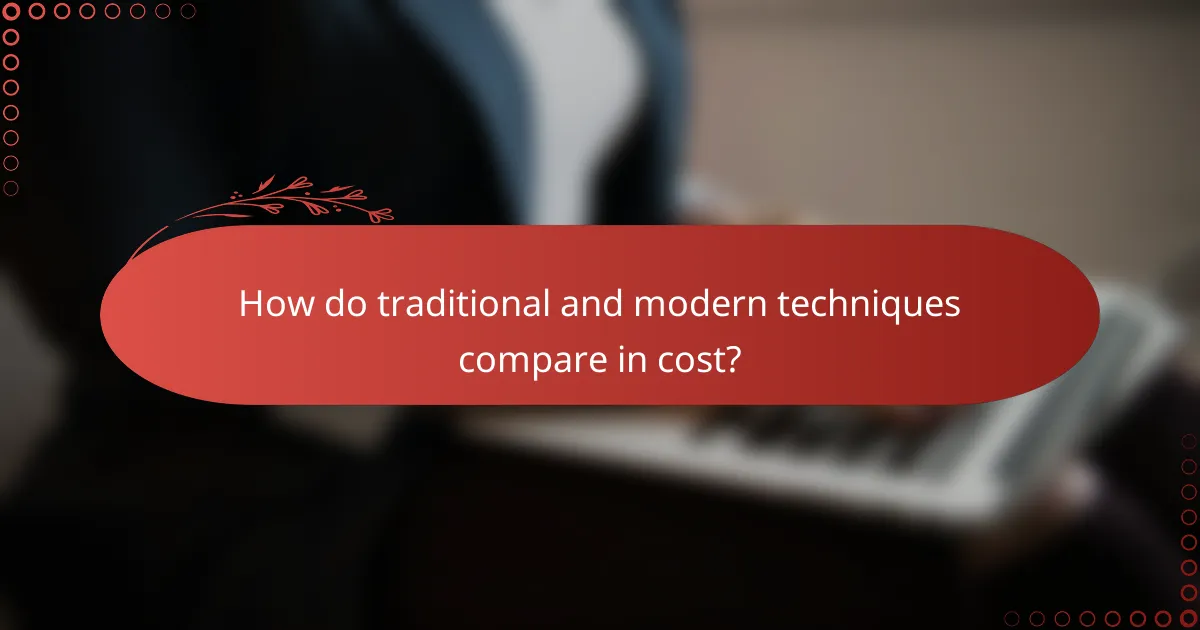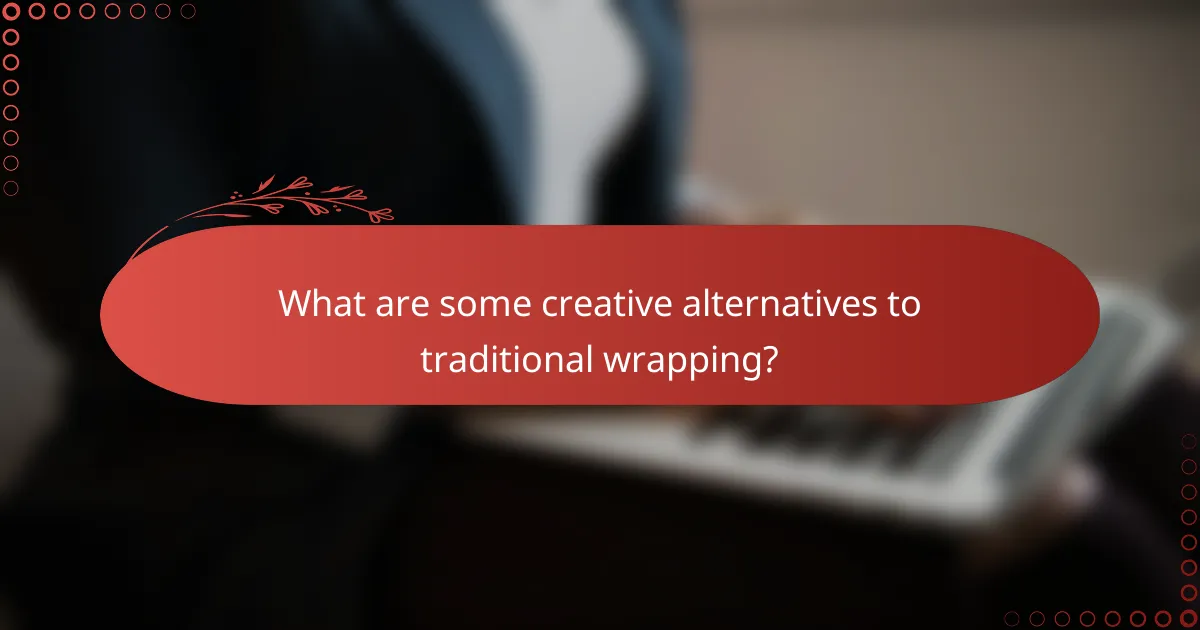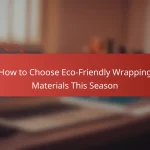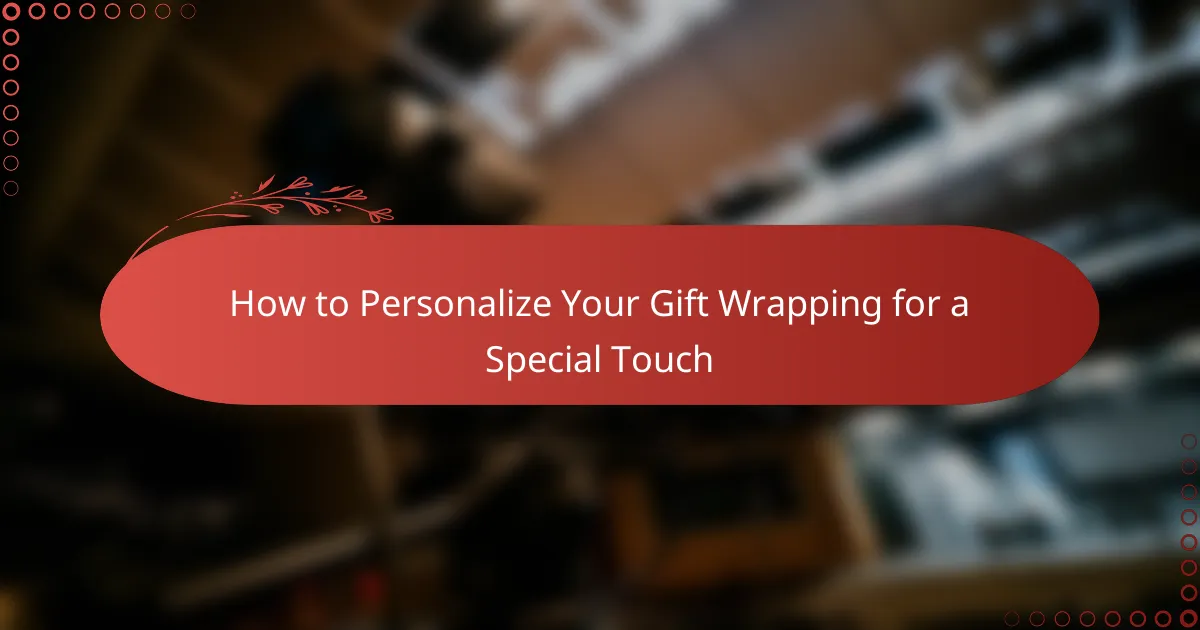Gift wrapping has evolved significantly over the years, with traditional techniques offering timeless charm and modern methods emphasizing sustainability and personalization. While classic approaches like paper wrapping and decorative bows enhance the joy of giving, contemporary styles focus on efficiency and eco-friendly materials. By comparing these two styles, you can choose the best wrapping technique that aligns with your values and enhances your gifting experience.

What are the best traditional gift wrapping techniques?
The best traditional gift wrapping techniques include classic paper wrapping, fabric wrapping, gift bags, ribbons and bows, and decorative elements. Each method offers a unique way to present gifts, enhancing the overall experience of giving and receiving.
Classic paper wrapping
Classic paper wrapping involves using decorative paper to cover gifts, often secured with tape. This technique allows for a wide range of designs and colors, making it suitable for any occasion. When choosing wrapping paper, consider the recipient’s preferences and the event’s theme.
To achieve a polished look, measure the paper to ensure it covers the entire gift without excess. Avoid common pitfalls like uneven edges or visible tape by folding neatly and using double-sided tape for a cleaner finish.
Fabric wrapping
Fabric wrapping, often known as furoshiki, uses cloth to wrap gifts, providing an eco-friendly alternative to paper. This technique not only looks elegant but also allows the fabric to be reused, adding value to the gift. Choose a fabric that complements the gift and is appropriate for the occasion.
To wrap a gift in fabric, place the item in the center, fold the corners over, and tie them securely. This method can be more time-consuming but offers a unique and personal touch that paper cannot match.
Gift bags
Gift bags are a convenient option for wrapping gifts, especially for irregularly shaped items. They come in various sizes and designs, making it easy to find one that fits the gift perfectly. Simply place the gift inside, add tissue paper, and the presentation is complete.
When using gift bags, consider the weight of the item to ensure the bag can support it. Avoid overstuffing the bag, as this can lead to a messy appearance and difficulty in handling.
Ribbon and bows
Ribbons and bows are essential decorative elements that enhance the visual appeal of wrapped gifts. They can be made from various materials, including satin, grosgrain, or jute, and come in countless colors and styles. Adding a ribbon or bow can elevate even the simplest wrapping technique.
To create a beautiful bow, use a length of ribbon that is at least three times the width of the gift. Practice tying different styles, such as classic bows or simple knots, to find the look that best suits your gift.
Decorative elements
Incorporating decorative elements like tags, stickers, or natural items can personalize your gift wrapping. These additions can convey a message or theme, making the gift more meaningful. Consider using items like dried flowers, pinecones, or handmade tags for a unique touch.
When selecting decorative elements, ensure they complement the overall wrapping style. Avoid overcrowding the gift with too many embellishments, as this can detract from the presentation. Aim for a balanced look that highlights the gift itself.

What are the benefits of modern gift wrapping techniques?
Modern gift wrapping techniques offer numerous advantages, including sustainability, personalization, and efficiency. These methods often utilize innovative materials and designs that cater to contemporary preferences and environmental concerns.
Eco-friendly materials
Modern gift wrapping frequently employs eco-friendly materials such as recycled paper, biodegradable wraps, and reusable fabric. These options significantly reduce waste and the environmental impact associated with traditional wrapping methods.
Choosing sustainable materials not only helps the planet but also appeals to environmentally conscious recipients. Look for certifications like FSC (Forest Stewardship Council) when selecting paper products to ensure responsible sourcing.
Customizable options
Customization is a hallmark of modern gift wrapping, allowing for unique designs that reflect the recipient’s personality or the occasion. Options include personalized prints, colors, and even messages that can be printed directly on the wrapping material.
Utilizing online services or local print shops can help you create bespoke wrapping solutions. Consider incorporating themes or motifs that resonate with the recipient for a more thoughtful presentation.
Quick and easy methods
Modern wrapping techniques often prioritize speed and simplicity, making the process more efficient. Pre-made wraps, gift bags, and even reusable boxes can save time while still looking polished.
For those in a hurry, consider using fabric wraps like furoshiki, which can be tied in various styles and reused multiple times. This method reduces waste and adds a unique touch to your gifts.
Innovative designs
Innovative designs in modern gift wrapping include 3D elements, interactive features, and artistic patterns that elevate the presentation. Techniques like layering different materials or incorporating embellishments can create visually stunning gifts.
Explore trends such as minimalist aesthetics or bold graphics to find a style that suits your gifting needs. Staying updated with design trends can inspire fresh ideas and make your gifts stand out.

How do traditional and modern techniques compare in cost?
Traditional gift wrapping techniques often involve higher material costs compared to modern methods, which can utilize more cost-effective and sustainable options. Understanding the differences in material costs and long-term savings can help you make informed choices for your gift wrapping needs.
Traditional materials costs
Traditional gift wrapping typically uses materials like high-quality wrapping paper, ribbons, and decorative elements, which can add up quickly. A roll of premium wrapping paper may cost anywhere from $5 to $20, depending on the brand and design. Additionally, the use of specialty items like foil or embossed paper can further increase expenses.
Moreover, traditional techniques often involve more waste, as many of these materials are single-use. This can lead to higher costs over time if you frequently purchase new materials for each occasion.
Modern materials costs
Modern gift wrapping techniques often incorporate more affordable and eco-friendly materials, such as recycled paper, fabric, or reusable gift bags. These options can range from $1 to $10, making them budget-friendly alternatives. Many people are now opting for creative solutions like newspaper or brown paper, which can be both stylish and inexpensive.
Additionally, the rise of digital gift wrapping options, such as e-gift cards and virtual wrapping, eliminates material costs altogether, providing a zero-cost solution for gift giving.
Long-term savings
When considering long-term savings, modern gift wrapping techniques often prove more economical. By using reusable materials like fabric or decorative boxes, you can significantly reduce the need for constant repurchasing. This approach not only saves money but also minimizes waste, aligning with sustainable practices.
In contrast, traditional methods may lead to recurring expenses due to their single-use nature. Investing in durable, reusable wrapping options can yield savings over time, making modern techniques a more cost-effective choice for frequent gift givers.

What are the environmental impacts of gift wrapping?
The environmental impacts of gift wrapping are significant, primarily due to the materials used and the waste generated. Traditional wrapping paper often ends up in landfills, while modern techniques aim to reduce waste and promote sustainability.
Traditional waste issues
Traditional gift wrapping typically involves materials like plastic-coated paper, ribbons, and tape, which are not recyclable and contribute to landfill waste. Each holiday season, millions of tons of wrapping paper are discarded, leading to increased waste management challenges.
Additionally, the production of these materials consumes resources and energy, further exacerbating their environmental footprint. Many consumers are unaware that even seemingly recyclable paper may contain non-recyclable components, complicating recycling efforts.
Modern sustainability practices
Modern gift wrapping practices focus on sustainability by utilizing eco-friendly materials such as recycled paper, fabric wraps, and reusable gift bags. These alternatives not only minimize waste but also often require less energy to produce.
Some popular sustainable options include using newspaper, brown kraft paper, or even biodegradable materials. Consumers are encouraged to consider wrapping gifts in items that can serve a dual purpose, like a scarf or a tote bag, reducing the need for additional wrapping materials.

How to choose the right gift wrapping technique for your occasion?
Choosing the right gift wrapping technique depends on the event, the recipient’s preferences, and your budget. Each factor plays a crucial role in ensuring that your gift is presented in a way that enhances the overall experience.
Consider the event type
The type of event significantly influences your wrapping choice. For formal occasions like weddings or corporate events, opt for elegant materials such as satin or high-quality paper. In contrast, casual events like birthdays may allow for more playful designs, such as colorful patterns or themed wrapping paper.
Additionally, consider the season. Holiday gifts often benefit from festive wrapping, while gifts for anniversaries might be better suited to more sophisticated styles. Tailoring your wrapping to the event creates a more thoughtful presentation.
Evaluate recipient preferences
Understanding the recipient’s tastes is essential when selecting a wrapping technique. If they appreciate sustainability, consider using recycled paper or fabric wraps. For someone who enjoys a specific theme, such as a favorite color or hobby, choose wrapping that reflects those interests.
Moreover, consider the recipient’s personality. A minimalist might prefer simple, understated wrapping, while a creative individual may appreciate bold, artistic designs. Personalizing the wrapping enhances the gift’s impact.
Assess budget constraints
Your budget will dictate the materials and techniques you can use for gift wrapping. High-quality wrapping paper and embellishments can range from a few dollars to significantly more, depending on the brand and design. Set a budget to avoid overspending while still achieving a beautiful presentation.
To save costs, consider DIY options like using newspaper or fabric scraps, which can be both economical and unique. Additionally, buying wrapping supplies in bulk can reduce overall expenses. Balancing quality and cost is key to effective gift wrapping.

What are some creative alternatives to traditional wrapping?
Creative alternatives to traditional gift wrapping include using materials like fabric, newspaper, or even reusable bags. These options not only reduce waste but also add a unique touch to your gifts.
Fabric Wrapping
Fabric wrapping, often known as furoshiki, involves using a piece of cloth to wrap gifts. This method is eco-friendly and allows for beautiful designs and textures. Consider using cotton or silk, which can be reused by the recipient.
To wrap a gift using fabric, place the item in the center of the cloth, fold the corners over the gift, and tie them securely. This technique works well for oddly shaped items and can be customized with different fabrics for various occasions.
Newspaper and Magazine Pages
Using newspaper or magazine pages is a creative way to wrap gifts while promoting recycling. This method can add a vintage or artistic flair, depending on the print used. Choose pages with colorful images or interesting articles to make the wrapping more appealing.
When wrapping with newspaper, consider layering it with a ribbon or twine for a polished look. This approach is budget-friendly and can be a fun project, especially for children who want to personalize their gifts.
Reusable Gift Bags
Reusable gift bags are a practical alternative to traditional wrapping paper. These bags come in various sizes and designs, making them suitable for any occasion. They can be used multiple times, reducing waste and saving money in the long run.
When selecting reusable bags, look for sturdy materials like canvas or jute. Personalize them with tags or decorations to add a special touch. This option is especially convenient for last-minute gifts, as it eliminates the need for wrapping altogether.










